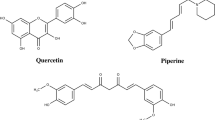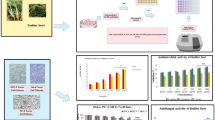Abstract
Amoebic keratitis and granulomatous amoebic encephalitis are caused by some strains of free-living amoebae of the genus Acanthamoeba. In the case of keratitis, one of the greatest problems is the disease recurrence due to the resistance of parasites, especially the cystic forms, to the drugs that are currently used. Some essential oils of plants have been used as potential active agents against this protist. Thus, the aim of this study was to determine the amebicidal activity of essential oils from plants of the genus Lippia against Acanthamoeba polyphaga trophozoites. To that end, 8 × 104 trophozoites were exposed for 24 h to increasing concentrations of essential oils from Lippia sidoides, Lippia gracilis, Lippia alba, and Lippia pedunculosa and to their major compounds rotundifolone, carvone, and carvacrol. Nearly all concentrations of oils and compounds showed amebicidal activity. The IC50 values for L. sidoides, L. gracilis L. alba, and L. pedunculosa were found to be 18.19, 10.08, 31.79, and 71.47 μg/mL, respectively. Rotundifolone, carvacrol, and carvone were determined as the major compounds showing IC50 of 18.98, 24.74, and 43.62 μg/mL, respectively. With the exception of oil from L. alba, the other oils evaluated showed low cytotoxicity in the NCI-H292 cell line. Given these results, the oils investigated here are promising sources of compounds for the development of complementary therapy against amoebic keratitis and granulomatous amoebic encephalitis and can also be incorporated into cleaning solutions to increase their amebicidal efficiency.



Similar content being viewed by others
References
Adams RP (2007) Identification of essential oil components by gas chromatography/mass spectrometry. Allured Pub Corp, USA
Botelho MA, Nogueira NA, Bastos GM, Fonseca SG, Lemos TL, Matos FJ, Montenegro D, Heukelbach J, Brito GA, Rao VS (2007) Antimicrobial activity of the essential oil from Lippia sidoides, carvacrol and thymol against oral pathogens. Braz J Med Biol Res 40(3):349–356
Clardy J, Walsh C (2004) Lessons from natural molecules. Nature 432(7019):829–837
Clarke DW, Niederkorn JY (2006) The pathophysiology of Acanthamoeba keratitis. Trends Parasitol 22(4):175–180
Dart JK, Saw VPJ, Kilvington S (2009) Acanthamoeba keratitis: diagnosis and treatment update 2009. Am J Ophthalmol 148(4):487–499
Degerli S, Tepe B, Celiksoz A, Berk S, Malatyali E (2012) In vitro amoebicidal activity or Origanum syriacum and Origanum laevigatum on Acanthamoeba castellani cysts and trophozoites. Exp Parasitol 131(1):20–24
Escobar P, Milena Leal S, Herrera LV, Martinez JR, Stashenko E (2010) Chemical composition and antiprotozoal activities of Colombian Lippia spp essential oils and their major components. Mem Inst Oswaldo Cruz 105(2):184–190
Farias-Junior PA, Rios MC, Moura TA, Almeida RP, Alves PB, Blank AF, Fernandes RP, Scher R (2012) Leishmanicidal activity of carvacrol-rich essential oil from Lippia sidoides Cham. Biol Res 45(4):399–402
Khan NA, Siddiqui R (2009) Acanthamoeba affects the integrity of human brain microvascular endothelial cells and degrades the tight junction protein. Int J Parasitol 39(14):1611–1616
Lima GP, Souza TM, Paula Freire G, Farias DF, AP C, Ricardo NM, de Morais SM, Carvalho AF (2013) Further insecticidal activities of essential oils from Lippia sidoides and Croton species against Aedes aegypti L. Parasitol Res 112(5):1953–1958
Lorenzo-Morales J, Khan NA, Walochnik J (2015) An update on Acanthamoeba keratitis: diagnosis, pathogenesis and treatment. Parasite 22:10
Malatyali E, Tepe B, Degerli S, Berk S, Akpulat HA (2012) In vitro amoebicidal activity of four Peucedanum species on Acanthamoeba castellanii cysts and trophozoites. Parasitol Res 110(1):167–174
Melo JO, Bitencourt TA, Fachin AL, Cruz EM, Jesus HC, Alves PB, Fátima Arrigoni-Blank M, Castro Franca S, Beleboni RO, Fernandes RP, Blank AF, Scher R (2013) Antidermatophytic and antileishmanial activities of essential oils from Lippia gracilis Schauer genotypes. Acta Trop 128(1):110–115
Menezes LR, Santos NN, Dos Santos JA, Meira CS, Guimaraes ET, Soares MB, Nepel A, Barisone A, Costa EV (2014) A new source of (R)-limonene and rotundifolone from leaves of Lippia pedunculosa (Verbenaceae) and their trypanocidal properties. Nat Prod Commun 9(6):737–739
Mosmann T (1983) Rapid colorimetric assay for cellular growth and survival: application to proliferation and cytotoxicity assays. J Immunol Methods 65(1-2):55–63
Ocazionez RE, Meneses R, Torres FA, Stashenko E (2010) Virucidal activity of Colombian Lippia essential oils on dengue virus replication in vitro. Mem Inst Oswaldo Cruz 105(3):304–309
Petry F, Torzewski M, Bohl J, Wilhelm-Schwenkmezger T, Scheid P, Walochnik J, Michel R, Zöller L, Werhahn KJ, Bhakdi S, Lackner KJ (2006) Early diagnosis of Acanthamoeba infection during routine cytological examination of cerebrospinal fluid. J Clin Microbiol 44(5):1903–1904
Polat ZA, Vural A, Ozan F, Tepe B, Özcelik S, Cetin A (2008) In vitro evaluation of the amoebicidal activity of garlic (Allium sativum) extract on Acanthamoeba castellanii and its cytotoxic potential on corneal cells. J Ocul Pharmacol Ther 24(1):8–14
Rodrigues FAR, Bomfim IS, Cavalcanti BC, Pessoa C, Gonçalves RSB, Wardell JL, Wadell SMSV, Souza MVN (2014) Mefloquine–oxazolidine derivatives: a new class of anticancer agents. Chem Biol Drug Des 83:126–131
Sauter IP, Santos JC, Apel MA, Cibulski SP, Roehe PM, von Poser GL, Rott MB (2011) Amoebicidal activity and chemical composition of Pterocaulon polystachyum (Asteraceae) essential oil. Parasitol Res 109(5):1367–1371
Sauter IP, Rossa GE, Lucas AM, Cibulski SP, Roehe PM, Silva LAA, Rott MB, Vargas RMF, Cassel E, von Poser GL (2012) Chemical composition and amoebicidal activity of Piper hispidinervum (Piperaceae) essential oil. Ind Crop Prod 40:292–295
Scheid P, Zöller L, Pressmar S, Richard G, Michel R (2008) An extraordinary endocytobiont in Acanthamoeba sp. isolated from a patient with keratitis. Parasitol Res 102(5):945–950
Sifaoui I, López-Arencibia A, Martín-Navarro CM, Chammem N, Mejri M, Lorenzo-Morales J, Abderabba M, Piñero JE (2013) Activity assessment of Tunisian olive leaf extracts against the trophozoite stage of Acanthamoeba. Parasitol Res 113(2):755–759
Vandendool H, Kratz PD (1963) A generalization of the retention index system including linear temperature programmed gas-liquid partition chromatography. J Chromatogr 11:463–471
Visvesvara GS (2010) Amebic meningoencephalitides and keratitis: challenges in diagnosis and treatment. Curr Opin Infect Dis 23(6):590–594
Vunda SL, Sauter IP, Cibulski SP, Roehe PM, Bordignon SA, Rott MB, Apel MA, von Pose GL (2012) Chemical composition and amoebicidal activity of Croton pallidulus, Croton ericoides, and Croton isabelli (Euphorbiaceae) essential oils. Parasitol Res 111(3):961–966
Acknowledgments
The authors thank Coordenação de Aperfeiçoamento de Pessoal de Nível Superior (CAPES) and Fundação de Apoio à Pesquisa e Inovação Tecnológica do Estado de Sergipe (FAPITEC) for their financial support to conduct this research (Acordo CAPES/FAPITEC 2345/2012).
Author information
Authors and Affiliations
Corresponding author
Rights and permissions
About this article
Cite this article
Santos, I.G.d.A., Scher, R., Rott, M.B. et al. Amebicidal activity of the essential oils of Lippia spp. (Verbenaceae) against Acanthamoeba polyphaga trophozoites. Parasitol Res 115, 535–540 (2016). https://doi.org/10.1007/s00436-015-4769-4
Received:
Accepted:
Published:
Issue Date:
DOI: https://doi.org/10.1007/s00436-015-4769-4




